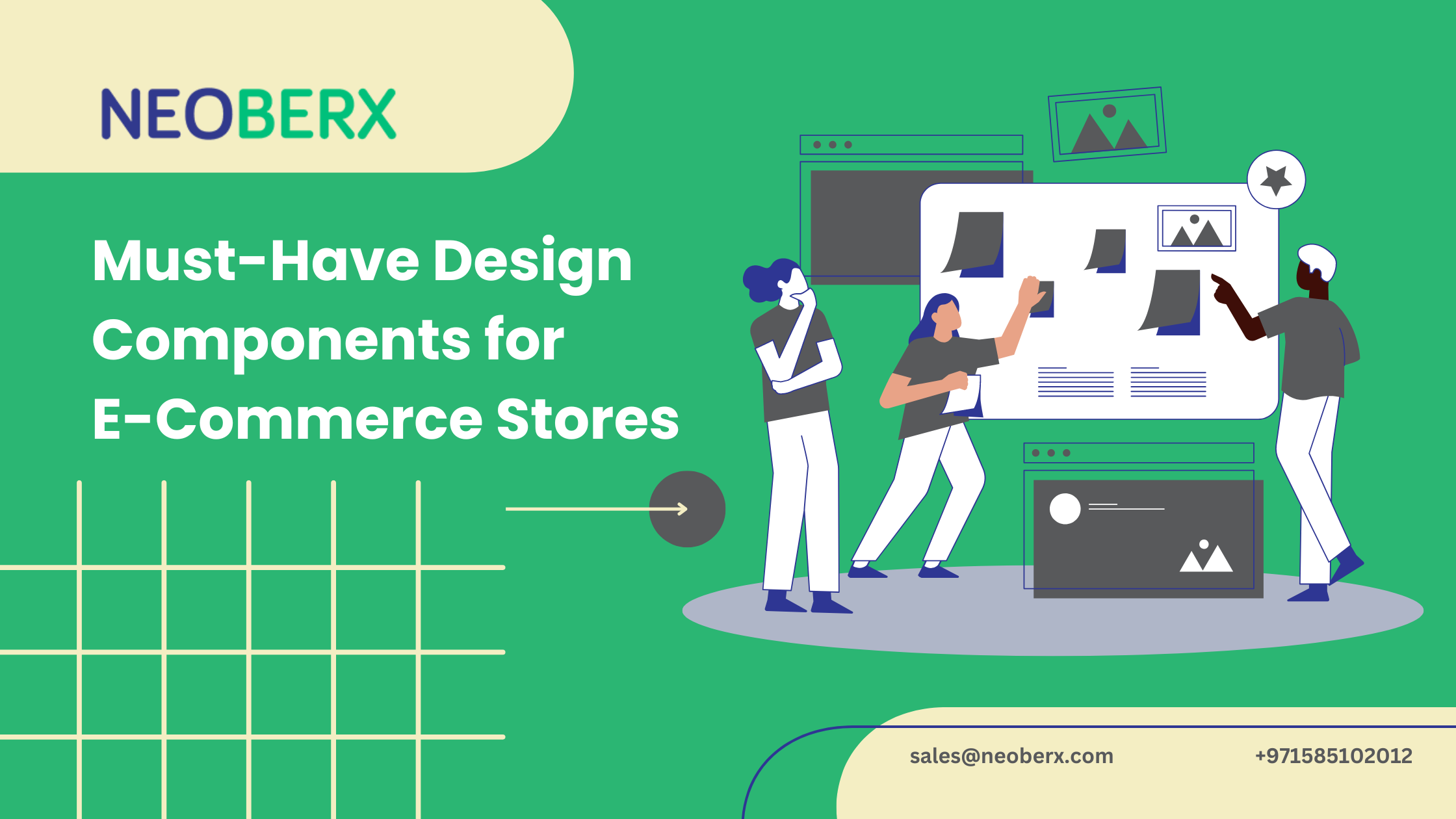In the competitive world of online shopping, having a well-designed e-commerce store is crucial. Your website needs to not only look appealing but also provide an exceptional user experience. Here are ten essential design components that your e-commerce store must have to stand out and succeed.
Definition of E-Commerce Store Design
E-commerce store design encompasses the visual and functional aspects of an online store, aimed at creating an engaging and efficient shopping experience. This involves everything from the layout and aesthetics to the ease of navigation and checkout processes.
Importance of Good Design for E-Commerce Success
Good design is crucial for the success of an e-commerce store. It not only attracts customers but also influences their shopping behavior, enhances user experience, and builds trust. An intuitive and visually appealing design can significantly increase conversion rates and customer satisfaction.
Top Important Design Elements for eCommerce Stores
The essential design components for an e-commerce store include user experience (UX) design, visual design, product display, checkout process, search functionality, personalization, content strategy, security, technical aspects, and accessibility. Each component plays a vital role in creating a seamless and enjoyable shopping experience.
1. Responsive Design
With the increasing use of mobile devices for online shopping, a responsive design is non-negotiable. Your website should look and function well on all devices, including desktops, tablets, and smartphones. A responsive design not only improves user experience but also positively impacts your search engine ranking. Key considerations include:
- Adaptive Layouts: Content should resize and reorder according to the screen size.
- Touch-Friendly Elements: Buttons and links should be easy to tap.
- Fast Loading Times: Optimize images and scripts to load quickly on mobile devices.
2. User-Friendly Navigation
A clear and intuitive navigation system is the backbone of any e-commerce site. Customers should be able to find what they’re looking for quickly and easily. Implementing a well-organized menu, along with a powerful search function, ensures that visitors can navigate your store effortlessly. Use categories and subcategories to keep everything structured and avoid overwhelming users with too many options. Consider implementing:
- Simple Menu Structures: Avoid overloading your menu with too many categories.
- Breadcrumbs: Help users keep track of their location within your site.
- Search Bar: An easily accessible search bar can drastically improve user experience.
3. High-Quality Images and Videos
Visual content plays a crucial role in e-commerce. High-quality images and videos help customers get a better understanding of the products, which can significantly influence their purchasing decisions. Use multiple images from different angles and include videos demonstrating the product in use. This approach can help reduce returns and increase customer satisfaction. Here’s how to make the most of visual content:
- Multiple Angles: Show products from different angles.
- Zoom Functionality: Allow users to zoom in on product details.
- Product Videos: Demonstrate the product in use to enhance understanding and desirability.
4. Fast Loading Speed
In the digital age, patience is scarce. A slow-loading website can frustrate users and drive them away. Optimize your website’s performance by compressing images, leveraging browser caching, and using a content delivery network (CDN). A fast-loading site improves user experience and boosts your search engine ranking. nsure your e-commerce store has a fast loading speed by:
- Optimizing Images: Use compressed, web-friendly image formats.
- Minimizing Scripts: Reduce the number of heavy scripts and plugins.
- Using a Content Delivery Network (CDN): Distribute content efficiently to users globally.
5. Clear Call-to-Actions (CTAs)
CTAs are critical for guiding users towards taking the desired actions, such as making a purchase or signing up for a newsletter. Ensure that your CTAs are prominently placed, visually appealing, and use action-oriented language. Phrases like “Buy Now,” “Add to Cart,” and “Sign Up Today” can motivate users to take the next step. They should be:
- Visible: Use contrasting colors to make CTAs stand out.
- Concise: Use brief, action-oriented text like “Buy Now” or “Add to Cart.”
- Strategically Placed: Position CTAs where users naturally look or scroll.
6. Detailed Product Descriptions
Clear, concise, and informative product descriptions help customers make informed decisions. Include all necessary details such as size, material, dimensions, and care instructions. Highlight unique features and benefits, and consider using bullet points for easy readability. Ensure your descriptions are:
- Informative: Include all necessary details such as size, material, and usage instructions.
- Engaging: Write in a conversational style to engage customers.
7. Secure Payment Gateways
Security is a top concern for online shoppers. Ensure that your e-commerce store offers secure payment options and displays trust signals, such as SSL certificates and secure payment badges. Providing multiple payment methods, including credit cards, PayPal, and other popular options, can also enhance the user experience. Key features include:
- SSL Certificates: Encrypt data to protect information.
- Multiple Payment Options: Offer various payment methods such as credit cards, PayPal, and other digital wallets.
- Trust Badges: Display security logos to reassure customers of their data’s safety.
8. Robust Customer Support
Accessible and effective customer support is vital for any e-commerce store. Offer multiple channels for customer support, including live chat, email, and phone support. A comprehensive FAQ section can also help address common questions and issues, reducing the need for direct contact. Key components include:
- Live Chat: Offer real-time assistance to customers.
- FAQ Section: Provide answers to common questions.
- Contact Information: Make it easy for customers to reach you via email, phone, or social media.
9. Wishlist and Save for Later Options
Allowing customers to save products for later can improve their shopping experience and increase the likelihood of future purchases. Wishlists enable users to keep track of items they are interested in and can also provide valuable insights into customer preferences and trends. Implement features like:
- Add to Wishlist Button: Let users save products for future purchase.
- Save for Later Option: Enable users to move items from their cart to a saved list.
10. Customer Reviews and Ratings
Customer reviews and ratings build trust and credibility. Display them prominently on your product pages. Encourage satisfied customers to leave reviews and respond to any negative feedback professionally and promptly. Implement:
- Review Sections: Allow customers to leave and read reviews on product pages.
- Star Ratings: Use a star rating system to quickly convey product quality.
- Testimonials: Feature customer testimonials on your homepage or dedicated sections.
11. Personalized User Experience
Personalization can significantly enhance the user experience. Use data-driven insights to provide personalized product recommendations, tailored offers, and relevant content. A personalized shopping experience can increase customer satisfaction and loyalty. Implement features such as:
- Product Recommendations: Use algorithms to suggest products based on browsing history.
- Personalized Emails: Send tailored email campaigns with relevant product suggestions.
- Customizable Products: Allow users to customize products to their preferences.
12. Secure and Easy Checkout Process
Including customer reviews and testimonials can significantly influence purchasing decisions. Positive reviews build trust and provide social proof. Make sure to display reviews prominently on product pages and consider incorporating a rating system. Responding to reviews, both positive and negative, also shows that you value customer feedback. Key elements include:
- Guest Checkout: Allow customers to checkout without creating an account.
- Progress Indicators: Show users where they are in the checkout process.
- Minimal Steps: Keep the number of steps to a minimum and request only essential information.
13. Trust Signals
Building trust is crucial for converting visitors into customers. Incorporate trust signals such as customer reviews, ratings, secure payment icons, and return policies. Highlighting these elements can reassure potential buyers that your site is credible and reliable. Include:
- Customer Reviews: Display verified customer reviews prominently.
- Trust Badges: Show security badges and certifications.
- Clear Return Policies: Make your return and refund policies easily accessible and understandable.
14. Effective Search Functionality
An effective search functionality is essential for any e-commerce store. Implement a robust search engine with autocomplete suggestions, filters, and sorting options. This helps users quickly find the products they’re looking for, enhancing their shopping experience.Essential features include:
- Auto-Suggestions: Provide search suggestions as users type.
- Advanced Filters: Allow users to filter search results by categories, price, ratings, etc.
- Search History: Enable users to revisit their past searches easily.
15. Social Media Integration
Connect your store with social media platforms. Social media buttons allow customers to share their purchases, increasing your reach. Integrate social login options to streamline the account creation process. Key features to consider include:
- Social Sharing Buttons: Allow users to share products directly to their social media profiles.
- Social Login Options: Enable users to log in using their social media accounts for a quicker registration process.
- Embedded Feeds: Display your social media feeds on your website to keep visitors updated with your latest posts.
16. Engaging Content and Blogging
Content marketing is a powerful way to drive traffic to your e-commerce store and engage with your audience. Engaging content such as blog posts, how-to guides, and product videos can provide valuable information to your customers and position your brand as an authority in your industry. Regularly updating your blog with relevant and interesting content can also improve your SEO rankings and attract more visitors to your site.
17. Effective Use of White Space
Proper use of white space (the empty space between elements) helps to avoid a cluttered look, making the site easier to navigate and enhancing the overall aesthetic appeal. Ensure that:
- Balanced Layouts: Use white space to create balance between text, images, and other elements.
- Focus on Content: White space directs attention to important content and enhances readability.
- Visual Appeal: A clean design with adequate white space creates a professional and visually appealing website.
18. Consistent Branding
Consistent branding creates a cohesive and professional look for your e-commerce store. Use your brand’s colors, fonts, and logo consistently across all pages. A strong brand identity not only looks appealing but also helps in building brand recognition and trust. Key components include:
- Logo and Color Scheme: Use a consistent logo and color palette across all pages.
- Typography: Stick to a limited set of fonts to maintain a cohesive look.
- Brand Voice: Maintain a consistent tone and style in all written content.
Conclusion
Implementing these essential design components can significantly enhance the user experience on your e-commerce store, leading to higher customer satisfaction and increased sales. Focus on creating a seamless, enjoyable shopping experience, and your customers will keep coming back for more.
At Neoberx, a leading eCommerce development agency with a strong presence in Dubai, UAE, and India, we specialize in helping eCommerce store owners achieve these design goals. Our expert team offers comprehensive eCommerce design services and UI/UX design development services tailored to your specific needs.
Whether you need a complete store redesign or specific enhancements, we ensure your online store stands out with a user-friendly, visually appealing, and high-performing design. Partner with Neoberx to elevate your e-commerce business and provide your customers with the exceptional online shopping experience they deserve.


